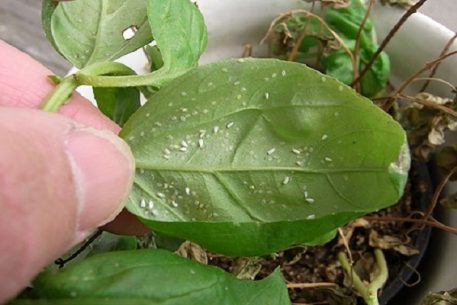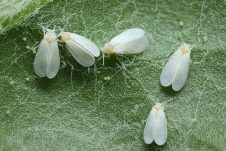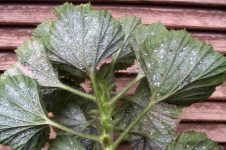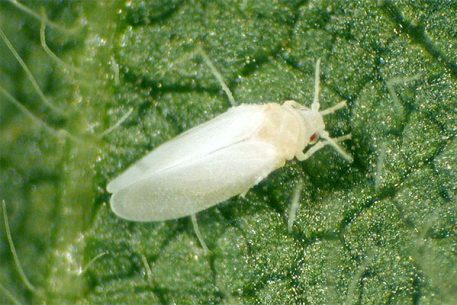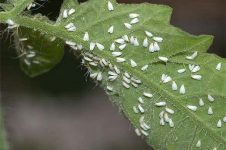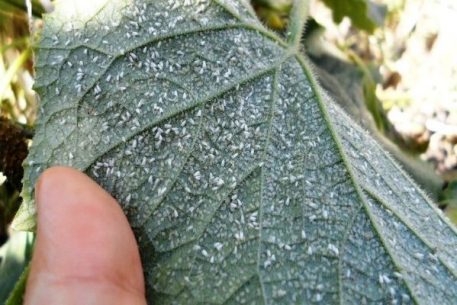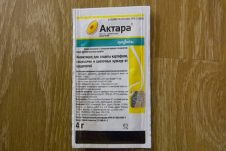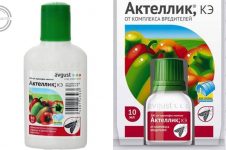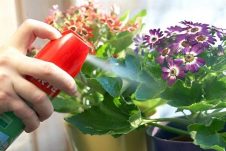White "moths", barely visible on plants, are dangerous pests. This is a whitefly, which among other half-winged insects stands out not only in miniature size. Adult individuals, similar to moths with folded wings, leave numerous offspring - voracious larvae sucking juices from plant leaves.
Material Content:
- 1 Types of Whiteflies
- 2 The reasons for the appearance on indoor plants and the greenhouse
- 3 How to notice whiteflies on plants?
- 4 Which plants are more susceptible to infection?
- 5 Whitefly on Indoor Flowers - How to Get Rid
- 6 Greenhouse Pest Management Methods
- 7 Effective ways to get rid of whitefly folk remedies
- 8 Preventative treatment
Types of Whiteflies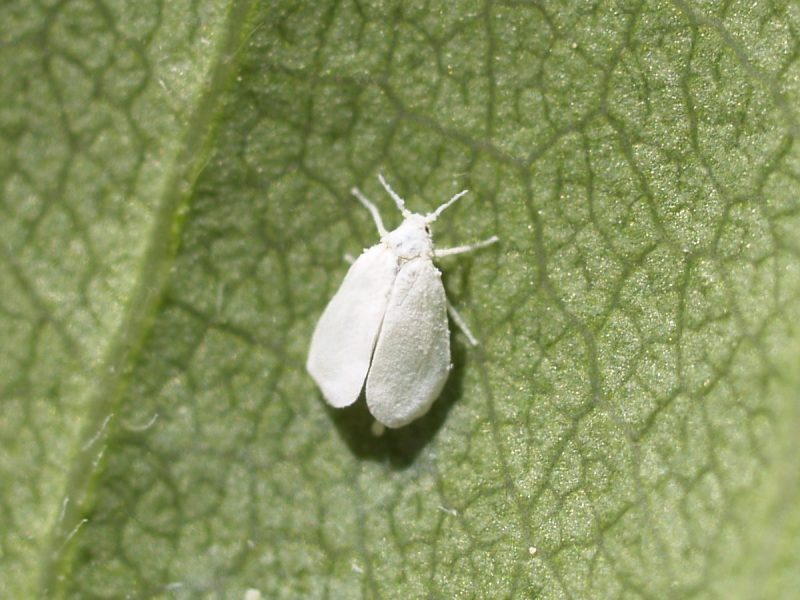
Insects belonging to the Aleyrodidae family attack almost all indoor plants, damage many flower, vegetable, berry crops in greenhouses and greenhouses. In regions with a temperate climate, strawberry, citrus, and cotton whiteflies live. Dozens more species belonging to the same family are found in the subtropics and tropics.
Whiteflies are common plant pests:
1. Tobacco (it’s also cotton). A dangerous quarantine object that damages about 600 species of grass and trees.
2. Greenhouse. It causes great harm to the flowers and vegetables of greenhouses.
3. Strawberry. Damages strawberry bushes and other fruit and berry plants.
4. Citrus. Quarantine pest of citrus.
The whitefly body reaches a length of 1.5 mm. On the back there are two pairs of wings folded in the shape of a “house”, as if sprinkled with light powder. Adult females attach eggs to the lower surface of the leaf. Larvae of the first age (crawlers) come out of them, which actively move in search of food and suck out juices from plant tissues.Crawlers leave a trace of a sugar substance.
Larvae molt several times before becoming adult - whiteflies. During the fourth stage of development, nymphs stop eating, release a wax-like coating that protects from the environment and pesticides. About a week later, adults emerge quickly reaching adulthood.
The reasons for the appearance on indoor plants and the greenhouse
Whiteflies in houses, apartments and sheltered ground find favorable conditions for reproduction and development. Insects need heat and moisture, the absence of natural enemies, a sufficient number of fodder plants (cultivated or wild). Small pests in greenhouses, greenhouses, indoor plants awaits "table and house."
In nature and protected ground, whiteflies hibernate at the stage of adult individuals and larvae, hide under the bark of trees, shrubs, among plant debris.
In greenhouses and greenhouses, pests are most often introduced with seedlings of vegetables. Whitefly on indoor flowers appears with new potted plants, cut flowers and soil. Once upon entering a house or apartment with bouquets, herbs, vegetables or soil, insects spread in a green corner. To infect indoor flowers is much easier than getting rid of a malicious pest.
How to notice whiteflies on plants?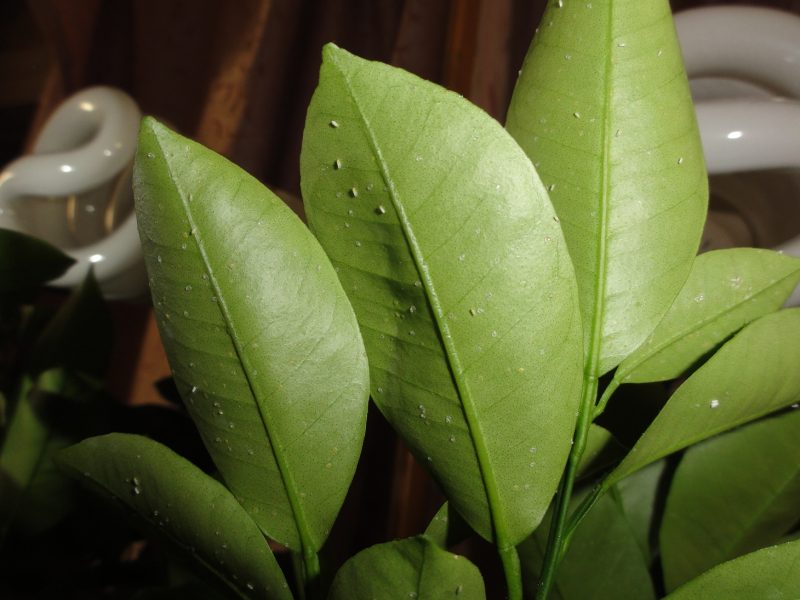
Attentive flower growers and summer residents will learn about insect pests already from the first traces of their life activity and the type of infected plants. If you specially or accidentally swing a flower on which adult whiteflies live, then white midges barely visible to the eye rise into the air. They whirl around flowers for a while.
Plants infected with voracious larvae quickly lose their decorative effect. Leaves turn yellow, change shape, buds are deformed, flowers do not bloom. Fungi, bacterial and viral pathogens attack a weakened plant organism. Whiteflies carry infectious pathogens of flowers and vegetables.
Which plants are more susceptible to infection?
Whiteflies settle in greenhouses on vegetable marrows, cucumbers, tomatoes, eggplants, wild strawberries. Many plants are infected in greenhouses and rooms. Gerberas, chrysanthemums, begonias, pelargoniums, balsamins, fuchsias, gloxinia suffer more than others.
Whitefly on Indoor Flowers - How to Get Rid
Adult insects can be harvested from plants with a vacuum cleaner. Hang in the places of the appearance of flying whiteflies and special traps (Velcro). As a measure of control and prevention, washing of plants under a cold shower is used. Large leaves are wiped with a wet swab to remove eggs and nymphs. You can add alcohol to the water.
Before you get rid of whiteflies with the help of "chemistry", you need to find out about the degree of safety of the selected drug and the possibility of its use in indoor flowers. To destroy insect pests in a house or apartment will help modern insecticides - neonicotinoids and pyrethroids.
Intestinal contact pesticide "Biotlin" causes the death of whiteflies and aphids within a few hours after treatment.
The insecticide "Aktara" is a universal drug used against most pests of indoor flowers and plants of open and protected soil.
• Dissolve 4 g of the drug in the form of granules in 5 l of water. Sprayed on the ground part of the plants.
• To water the substrate, prepare a solution of 0.5 - 1 g of Aktara granules and 5 l of water. The plants are treated with the drug 2 to 3 times with an interval of 7 days between sprayings, in order to destroy the stray larvae.
Greenhouse Pest Management Methods
To get rid of the wintering stages of insects, you can freeze the soil in the cold season. Adult flying whiteflies in the greenhouse are collected with a vacuum cleaner, hang traps (sticky paper tapes). Not all pests are sensitive to low temperatures, so freezing is not a panacea.Weeds should be more carefully removed during the growing season, to collect plant debris.
A greenhouse whitefly in a greenhouse can destroy an entire crop. A new systemic insecticide, Mospilan, is used to combat dangerous plant pests. Spraying with this preparation of flower-decorative cultures of greenhouses is carried out during the growing season. Vegetables are processed for the first time at the beginning of the growing season, the last 3 weeks before harvest.
You can fight with the help of other pesticides:
• “Commander”;
• “Aktara”;
• “Actellik”;
• "Funfanon Nova."
"Fitoverm" copes with whitefly only after repeated spraying or in combination with pyrethroid insecticides. Biological products are safer for humans and beneficial insects than chemicals. Of this group, the most popular is the “Aktofit” insect-acaricide.
Effective ways to get rid of whitefly folk remedies
A large group of plants has an insecticidal effect.
1. Herbs and leaves are crushed before the preparation of the spray solution.
2. Then the raw materials are boiled or insisted in cold water for several days.
3. The solution is filtered and soap is added to it to increase “sticking” to the leaves.
4. Once again, filter the liquid and apply for spraying.
Repeated treatments will be required after 3 to 4 days, since folk remedies are destroyed faster than synthetic pesticides.
Bitter wormwood is used against whiteflies. Cut grass, form “brooms” and hang them in a greenhouse or greenhouse. Infusion of fresh wormwood is sprayed with vegetables and flowers. Prepare the product from finely chopped herbs and water (1: 2), insist for a day, boil for 30 minutes, then dilute with an equal volume of water. Spray plants from a sprayer with small holes.
Personal protection methods when treating plants with folk remedies should be the same as when working with chemical preparations.
Also spray plants in a room or greenhouse with an infusion of garlic. Prepare the product from crushed cloves and water (170 g per 1 liter). Insist 5 days under the lid. A concentrated extract is obtained, which is diluted with water before use. A solution of garlic infusion is sprayed with leaves and water the ground under the plants. The treatments are repeated as new generations of whiteflies emerge.
Preventative treatment
If protective measures are not taken in a timely manner, then whiteflies infect all plants. It is difficult to get rid of a tiny pest. Repeated treatments with strong pesticides will be required.
• It is recommended to inspect purchased seedlings, cuttings, seedlings, identify infected specimens and treat them with folk remedies or pesticides.
• For prophylactic purposes, new potted flowers are sprayed with a weak solution of the insecticide used to control whiteflies.
• You can plant wormwood and tansy in the greenhouse, use infusions of insecticidal plants for watering indoor flowers.
• It is very important to collect and destroy plant debris, soil disinfection, disinfection of frames, window sills.
• Whiteflies winter in the upper layers of the soil, so a deep digging of the earth in the greenhouse, replacement of the substrate in pots is necessary.
High-quality prevention will help protect your green corner, and in case of infection, start the fight against the pest in time and prevent the death of plants.


